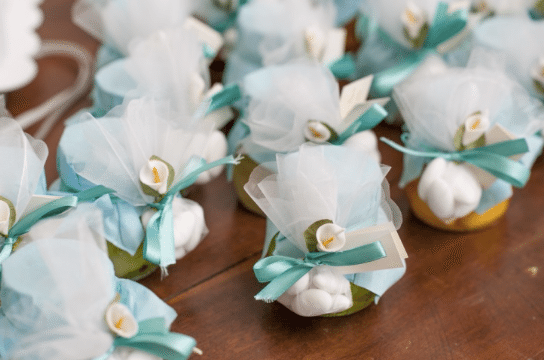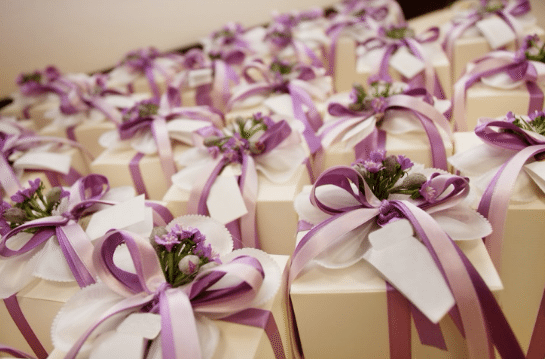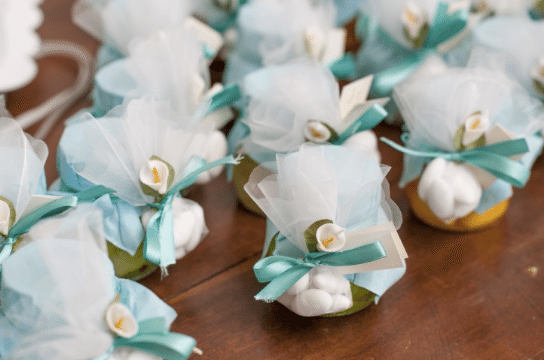As you begin thinking about favors to give your guests, you’re following in a tradition that began many hundreds of years ago and today is followed in many countries around the world. It’s a way of showing appreciation to the friends and relatives who’ve come to celebrate your marriage with you, as well as a way of expressing the symbolism of that very special event.
No matter what tradition you decide to uphold for your wedding favors, try not to go overboard. Although each favor may cost only a few dollars, the total can add up quickly. Don’t forget to include favors when you’re creating your wedding budget. And when you’re planning how you’re going to pay for favors and the many other details of your wedding, carefully check any bridal financing options and don’t jump at the first credit card you see, even if it’s offered by a full-service bridal salon.
Almonds: The First Favors
Greek mythology tells of a king of Athens named Demophon, who married Phyllis, the daughter of a neighboring king. The day after their wedding Demophon sailed off, promising he’d return. By the time he did, alas, Phyllis had died and turned into an almond tree. In despair, Demophon embraced the tree and it burst into bloom. The new life in the almond tree was seen as reflecting the endurance of their bond, and its fruit has continued to symbolize love and commitment to the present day.
The early Romans gave wedding favors of honey-coated almonds. By the 15th century, as trade in sugarcane reached Europe, confectioners coated the almonds in candy. Known as confetti to the Italians, koufetta to the Greeks, and mlabas in the Middle East, these treats were meant to represent how the natural bitterness of the almond is sweetened by the sugar, much as having a beloved spouse in your life can sweeten the hard times.
Jordan almonds coated in thin white or pastel sugar shells are still given as wedding favors today, and whether they’re packaged for giving in delicate tulle bags or other small containers, they’re always in handfuls of five to represent health, wealth, joy, fertility, and long life. The odd number is indivisible, symbolizing hope that the newlyweds remain inseparable and share all of life together.
Going Beyond Almonds
The first documented wedding favors other than almonds were given to guests at aristocratic weddings in England and France as early as the 16th century. These favors came in the form of small boxes made of crystal, porcelain, or gold, and at the most posh weddings, they were adorned with precious gems.
Within the boxes were sugar cubes or other confections. Sugar was still quite expensive and so it displayed the wealth of the wedding host while its sweetness was a token of hope for the new marriage. The precious gift boxes were called “bonbonnieres,” from bonbon — literally meaning “good good” — a French children’s word that came to mean a fancy bite-size candy.
English couples of the time who couldn’t afford sugar or elaborate containers gave “love knots” created of ribbons and lace, or other modest gifts. Receiving even the smallest token from the bride and groom meant sharing the good luck that had been bestowed upon them, and thus each wedding guest felt blessed.
Today’s Wedding Favors
While candied almonds are still given today, and the sweets tables at many weddings take the concept even further, the variety of today’s wedding favors is vast. Couples today have updated the tradition to include favors that reflect the theme, season, or colors of the wedding, or to express a sharing of interests that are personal to them.
A nice thought is to include a touch of your shared or individual heritages in your choices of favors, or to take your guests to your honeymoon destination with a favor that reflects its culture. Here are some examples:
- In Ireland, the bride and groom ring bells at their ceremony. They then take the bells home with them to ring as a reminder of their vows if they have an argument. In keeping, the guests are given small bells as favors.
- In Spain, male guests are given cigars while women are given folding fans or other feminine gifts
- In India, hand-carved elephants are seen as lucky wedding favors. Another choice might be small decorative incense holders in vibrant jewel tones with incense sticks or cones
- In Malaysia, the traditional wedding favor is a hand-painted egg that symbolizes fertility for the newlyweds.
- In China, Japan, and Korea, favors might be decorative chopsticks, wooden fans, tea cups, or other small items decorated with cherry blossoms or the ancient double happiness symbol.
No matter what, edible favors are always welcome. The flavors of the world are at your disposal, whether you purchase them or create them yourself. Jars of spices, honeys or jam, containers of teas or coffees, or delicacies from your own heritage or your honeymoon spot all make wonderful favors.




